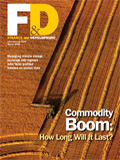 About F&D Subscribe Back Issues Write Us Copyright Information Free Email Notification Receive emails when we post new
items of interest to you. |
Back to Basics Mark Stone, Harald Anderson, and Romain Veyrune Exchange Rate Regimes: Fix or Float? Whether he knows it or not, the owner of a Pacific island surfboard shop thinking in March about the cost of buying 100 surfboards from his California supplier in July should care about his country's exchange rate regime. A country's exchange rate regime governs its exchange rate—that is, how much its own currency is worth in terms of the currencies of other countries. If the surfboard shop owner's country has a fixed exchange rate regime, under which the value of the local currency is tied to that of the U.S. dollar, then he can be confident that the price of surfboards in his currency won't change over the coming months. By contrast, if his country has a flexible exchange rate regime vis-à-vis the U.S. dollar, then its currency could go up or down in value during the change of seasons and he may want to allocate more, or less, local currency for his forthcoming surfboard purchase. If you extend the above scenario to all cross-country transactions, you can see that the exchange rate regime has a big impact on world trade and financial flows. And the volume of such transactions and the speed at which they are growing highlight the crucial role of the exchange rate in today's world, thereby making the exchange rate regime a central piece of any national economic policy framework. Types of regimes Hard pegs usually go hand in hand with sound fiscal and structural policies and low inflation. They tend to remain in place for a long time, thus providing a higher degree of certainty for pricing international transactions. However, the central bank in a country with a hard exchange rate peg has no independent monetary policy because it has no exchange rate to adjust and its interest rates are tied to those of the anchor-currency country. In the middle of the spectrum are soft exchange rate pegs— that is, currencies that maintain a stable value against an anchor currency or a composite of currencies. The exchange rate can be pegged to the anchor within a narrow (+1 or –1 percent) or a wide (up to +30 or –30 percent) range, and, in some cases, the peg moves up or down over time—usually depending on differences in inflation rates across countries. Costa Rica, Hungary, and China are examples of this type of peg. Although soft pegs maintain a firm "nominal anchor" (that is, a nominal price or quantity that serves as a target for monetary policy) to settle inflation expectations, they allow for a limited degree of monetary policy flexibility to deal with shocks. However, soft pegs can be vulnerable to financial crises—which can lead to a large devaluation or even abandonment of the peg—and this type of regime tends not to be long lasting. At the other end of the spectrum are floating exchange rate regimes. As the name implies, the floating exchange rate is mainly market determined. In countries that allow their exchange rates to float, the central banks intervene (through purchases or sales of foreign currency in exchange for local currency) mostly to limit short-term exchange rate fluctuations. However, in a few countries (for example, New Zealand, Sweden, Iceland, the United States, and those in the euro area), the central banks almost never intervene to manage the exchange rates. Floating regimes offer countries the advantage of maintaining an independent monetary policy. In such countries, the foreign exchange and other financial markets must be deep enough to absorb shocks without large exchange rate changes. Also, financial instruments must be available to hedge the risks posed by a fluctuating exchange rate. Almost all advanced economies have floating regimes, as do most large emerging market countries. Common language The IMF has developed the most widely used language and terminology for classifying exchange rate regimes, as part of its mandate to oversee the exchange rate policies of its member countries. Historically, exchange rate regimes reported by the IMF were based on a country's own classification, that is, a de jure regime. But starting in 1999, the IMF also began to report de facto—that is, observed—exchange rate regimes based on the IMF staff 's assessment of available information. And a comparison of de jure and de facto regimes shows a fair number of discrepancies (see box). Shifting trends
This "hollowing out of the middle" came to a halt in 2001. The period since then has seen a more subtle shift in countries' exchange rate regime choices. Within the floating group, more countries are now managing the exchange rate rather than floating independently, and soft pegs have also regained some of their earlier popularity. Many countries are not able or willing to commit to a hard peg, but neither are they able to float freely because of gaps in financial markets and because exchange rate changes can seriously affect countries' balance sheets, inflation, and growth. Moreover, in a number of cases, the de facto shift toward more tightly managed regimes has occurred without a declared (de jure) change in exchange rate policies. What the future holds Another school stresses the benefits of a floating exchange rate and independent monetary policy and predicts the continued existence of a large number of national currencies tethered to various nominal anchors. Whether a large number of floating exchange rate currencies remain, or whether they coalesce into a small number of bloc currencies, will have very different implications for businesses, policymakers, and owners of surfboard shops.
|